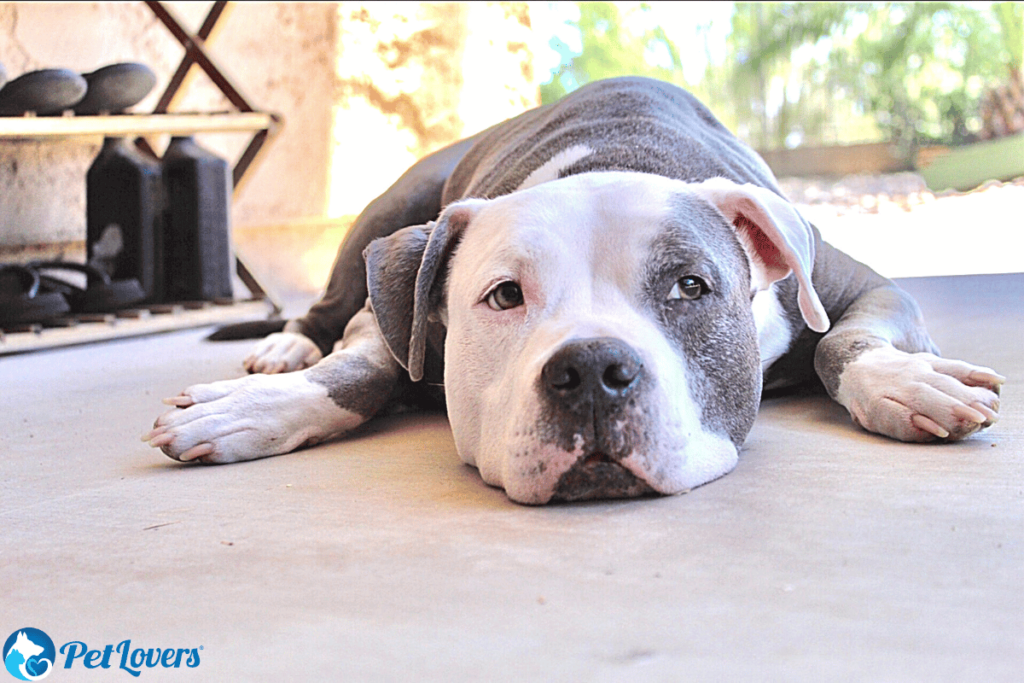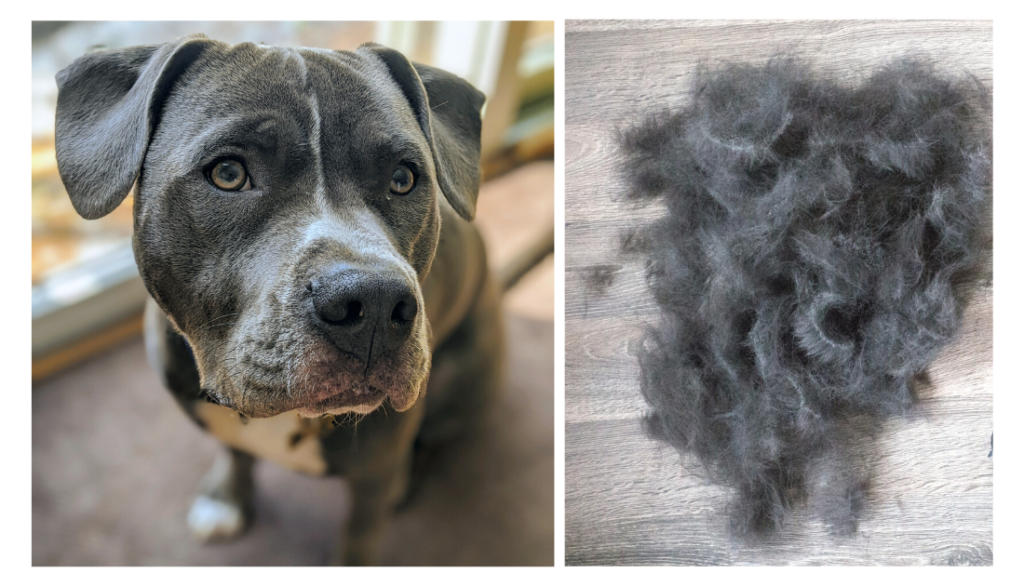Do Pitbulls shed a lot? Well, you might be surprised to learn that despite their short hair, Pitbulls are actually moderate shedders. While they may not have long, fluffy coats, they still have a dense and thick coat that can shed throughout the year.
When it comes to the shedding of Pitbulls, it’s important to understand their history. Pitbulls were originally bred for their strength and agility in activities like bull-baiting. As a result, they developed a short, smooth coat that is easy to maintain. However, this coat still sheds to some extent, especially during seasonal changes. It’s important to brush them regularly to minimize shedding and keep their coat healthy. By doing so, you can reduce the amount of loose hair around your home and keep your Pitbull looking their best.
Pitbulls are known to have a moderate shedding level. While they do shed, it’s not excessive compared to some other breeds. Regular brushing can help control shedding and keep your pitbull’s coat healthy. Additionally, providing a balanced diet rich in omega-3 fatty acids can improve their coat condition. Consider using grooming tools like deshedding brushes to minimize shedding. Overall, pitbulls are relatively low-maintenance in terms of shedding compared to other breeds.

Do Pitbulls Shed a Lot? The Truth Revealed
When it comes to owning a Pitbull, one of the common concerns potential owners have is shedding. Many people wonder if Pitbulls shed a lot, and if so, how to manage the shedding. In this article, we will delve deep into the shedding habits of Pitbulls, discussing the factors that contribute to shedding, tips to control it, and whether or not the shedding is excessive compared to other breeds.
Understanding the Shedding Cycle
Pitbulls, like all dogs, naturally shed their fur to make way for new hair growth. Shedding is a normal process for dogs and plays a crucial role in maintaining healthy skin and coat. The shedding cycle consists of three main phases: anagen (active growth), catagen (transitional), and telogen (resting). During the telogen phase, old hairs fall out, making room for new hairs to grow.
Some factors can influence a Pitbull’s shedding, such as changes in season, hormonal changes due to pregnancy or reproductive cycles, diet, stress, and underlying health issues. It’s essential to keep these factors in mind when assessing the amount of shedding in Pitbulls.
While shedding is a natural part of a Pitbull’s life, some breeds may shed more than others due to their genetics and different coat types. Let’s explore the shedding tendencies of Pitbulls in more detail.
Pitbull Shedding Habits: What to Expect
Pitbulls have short, single-layered coats that give them that signature sleek and shiny appearance. The good news is that Pitbulls are not heavy shedders compared to some other breeds. Their short hair generally makes it easier to manage shedding than dogs with longer or denser coats.
Pitbulls typically have a consistent shedding pattern throughout the year, with a slightly heavier shed during spring and fall. During these transitional seasons, Pitbulls may shed their winter coat to prepare for the warmer summer or thicker winter coat. Regular brushing, especially during shedding seasons, can help remove loose hairs and minimize shedding around the house.
It’s important to note that individual Pitbulls may have slight variations in their shedding habits. Factors like genetics, overall health, and diet can affect the amount of shedding. Additionally, Pitbull mixes with other breeds may have coat characteristics inherited from their parent breeds, potentially affecting shedding tendencies.
Tips to Manage Pitbull Shedding
Although Pitbull shedding is not excessive, there are some steps you can take to manage and minimize shedding:
- Regular brushing: Brushing your Pitbull’s coat two to three times a week can help remove loose hairs and prevent them from ending up on your furniture or clothes. Use a brush that suits your Pitbull’s coat type, such as a bristle brush or a rubber grooming mitt.
- Bathe your Pitbull: Regular bathing with a suitable dog shampoo can help remove loose hairs and keep your Pitbull’s coat healthy. Avoid frequent bathing as it can strip off the natural oils that keep the coat moisturized.
- Diet and nutrition: Providing your Pitbull with a balanced and nutritious diet supports healthy skin and coat. Consult with your veterinarian to ensure your Pitbull is getting the right nutrients for optimal coat health.
- Regular vet check-ups: Keeping up with routine veterinary care ensures that any underlying health issues contributing to excessive shedding can be identified and addressed promptly.
Pitbulls vs. Heavy Shedders: A Comparison
While Pitbulls do shed, their shedding habits are generally considered moderate compared to breeds known for heavy shedding, such as German Shepherds, Huskies, or Golden Retrievers. These breeds have thick double coats designed to protect them from harsh weather conditions, but as a result, they shed significantly more.
If you compare Pitbulls to breeds that have a similar coat length and type, such as Boxers or Dobermans, Pitbulls shed about the same or slightly less. However, individual variation can occur, and some Pitbulls may shed more or less than others depending on various factors we discussed earlier.
In conclusion, Pitbulls do shed, but the shedding is generally not excessive. Regular grooming, proper nutrition, and routine vet care can help minimize shedding and keep your Pitbull’s coat healthy and shiny.
The Importance of Regular Grooming and Care
Beyond managing shedding, regular grooming and care are crucial for maintaining the overall well-being of your Pitbull. Grooming helps keep their coat, skin, and nails healthy while also providing an opportunity to check for any signs of health issues. Here are a few areas to focus on:
Brushing
Regular brushing helps remove loose and dead hair, prevents matting, distributes natural oils, and stimulates the skin. It’s especially important for Pitbulls with longer or denser coats or during the shedding seasons. Brushing also allows you to inspect their skin for any abnormalities or signs of parasites.
Bathing
Bathing your Pitbull keeps their coat clean and free from dirt, allergens, and parasites. However, excessive bathing can strip their skin of natural oils, leading to dryness and irritation. Aim for bathing your Pitbull every 6-8 weeks or as needed, using a gentle dog shampoo specifically formulated for their skin type.
Ears, Eyes, and Teeth
Regularly check and clean your Pitbull’s ears to prevent ear infections. Wipe the outer ear with a damp cloth or use a vet-approved ear cleaning solution. Additionally, inspect their eyes for any discharge or redness and gently wipe the corners with a clean, damp cloth if necessary. Brush your Pitbull’s teeth regularly to maintain good oral hygiene and reduce the risk of dental problems.
Nail Care
Trimming your Pitbull’s nails regularly is essential to prevent them from becoming too long and causing discomfort or potential injury. Use a proper dog nail trimmer and be cautious not to cut into the quick, a sensitive area that can cause bleeding and pain.
Conclusion:
In conclusion, Pitbulls do shed, but their shedding is typically moderate and manageable. By regularly grooming and caring for your Pitbull, you can minimize shedding, keep their coat healthy, and maintain their overall well-being. Remember to consult with your veterinarian for specific advice tailored to your Pitbull’s individual needs. With the right care and attention, your Pitbull can have a beautiful, healthy coat that sheds just like any other dog breed.
Key Takeaways: Do Pitbulls Shed a Lot?
- Pitbulls are moderate shedders.
- They have short hair that can be easily managed.
- Different Pitbull breeds may have varying shedding levels.
- Regular brushing can help minimize shedding.
- Healthy diet and proper grooming can reduce excessive shedding.
Frequently Asked Questions
Below are some common questions about pitbull shedding:
1. How often do pitbulls shed their fur?
Pitbulls are moderate shedders and typically shed their fur throughout the year. However, they may have seasonal shedding periods where they shed more heavily, usually during spring and fall. During these times, you may find more fur around your home and notice increased grooming needs. Regular brushing can help manage the shedding and keep your pitbull’s coat healthy.
It’s important to note that the amount of shedding can vary among individual pitbulls. Factors such as genetics, diet, and overall health can influence how much they shed. If you have concerns about excessive shedding, it’s best to consult with a veterinarian.
2. Will grooming help reduce pitbull shedding?
Yes, regular grooming can help minimize pitbull shedding. Brushing your pitbull’s coat at least once a week can help remove loose fur and prevent it from spreading all over your home. Additionally, grooming allows you to inspect your dog’s coat for any skin issues or parasites.
It is recommended to use a brush that is suitable for your pitbull’s coat type, such as a slicker brush or a grooming glove. These tools can effectively remove loose hair without irritating your dog’s skin. Remember to be gentle and avoid brushing too aggressively, as pitbulls have sensitive skin.
3. Are there any specific dietary considerations to reduce shedding in pitbulls?
Providing your pitbull with a balanced diet can support a healthy coat and potentially reduce shedding. Essential fatty acids, such as Omega-3 and Omega-6, are beneficial for skin and coat health. You can find these nutrients in high-quality pet foods formulated for skin and coat support.
Consult with your veterinarian to determine the best diet for your pitbull’s specific needs. They can provide tailored recommendations based on factors like age, activity level, and any underlying health conditions that could contribute to excessive shedding.
4. Can environmental factors affect pitbull shedding?
Yes, environmental factors can influence pitbull shedding. Changes in temperature and daylight hours can trigger seasonal shedding. Additionally, dry indoor air, particularly during winter, can contribute to dry skin and increased shedding. Maintaining proper humidity levels in your home and using a humidifier if necessary can help alleviate this issue.
Pitbulls that spend a significant amount of time outdoors may also experience more shedding due to exposure to allergens, such as pollen or dust. Regular bathing and proper coat care can help mitigate the effects of environmental factors on shedding.
5. Should I be concerned if my pitbull is shedding excessively?
If your pitbull is shedding excessively or if you notice any other signs of skin irritation, such as redness, itching, or hair loss patches, it is essential to consult a veterinarian. Excessive shedding can be a symptom of underlying health issues, including allergies, hormonal imbalances, or skin infections. A veterinarian can evaluate your pitbull’s overall health and provide appropriate guidance and treatment if needed.
Remember, all dogs shed to some extent, but if you are concerned about the amount or frequency of shedding, don’t hesitate to seek professional advice for peace of mind and your pitbull’s well-being.

In summary, (I/we) believe that (state the main point) is important because (reasons or implications). By (taking action or considering these factors), (we/teenagers) can (achieve a certain outcome or benefit). Remember, (we/I) must (desired action or perspective) in order to (desired outcome). Let’s work together to (desired result) and make a positive impact. Keep (reason or motivation) in mind, and (conclusion or final thought).
